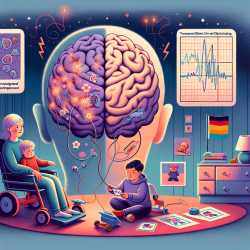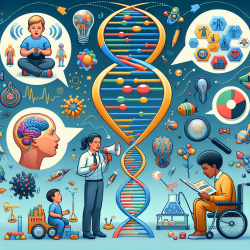Introduction
In the quest to improve therapeutic outcomes for children with Autism Spectrum Disorder (ASD), innovative approaches are constantly being explored. One such promising technique is Transcranial Direct Current Stimulation (tDCS), a non-invasive brain stimulation method. A recent study, "The Short-Term Effects of Transcranial Direct Current Stimulation on Electroencephalography in Children with Autism: A Randomized Crossover Controlled Trial," sheds light on the potential benefits of tDCS in enhancing cognitive and behavioral functions in children with autism.
Understanding tDCS and Its Mechanism
tDCS involves the application of a low electrical current to the scalp, which modulates neuronal activity. The study focused on anodal tDCS, which is known to increase neuronal excitability, applied over the left dorsolateral prefrontal cortex (F3). This area is crucial for cognitive processes such as working memory and social behavior, which are often impaired in children with autism.
Key Findings from the Study
The study involved 20 male children with autism, aged 5 to 8 years, in a crossover design receiving both active and sham tDCS. The results were compelling:
- Significant improvements were observed in the social and health/behavior domains of the Autism Treatment Evaluation Checklist (ATEC) following active tDCS compared to sham treatment.
- There was a notable increase in Peak Alpha Frequency (PAF) at the stimulation site, which correlated with improvements in the aforementioned ATEC domains.
- The findings suggest that a single session of anodal tDCS can yield short-term clinical benefits, potentially due to enhanced synaptic connectivity reflected by increased PAF.
Implications for Practitioners
For practitioners in speech language pathology and related fields, these findings open new avenues for intervention. Incorporating tDCS into therapeutic regimens could enhance outcomes for children with autism, particularly in improving social interactions and reducing behavioral issues. Practitioners are encouraged to consider the following:
- Explore the integration of tDCS with existing therapeutic practices to maximize benefits.
- Stay informed about ongoing research and advancements in non-invasive brain stimulation techniques.
- Consider collaborating with neuroscientists to tailor tDCS protocols that address specific cognitive and behavioral challenges in children with autism.
Encouraging Further Research
While the study provides promising insights, further research is essential to validate these findings and explore long-term effects. Larger sample sizes and diverse participant demographics could enhance the generalizability of the results. Additionally, investigating the combination of tDCS with other therapeutic modalities could provide a comprehensive approach to managing autism symptoms.
To read the original research paper, please follow this link: The Short-Term Effects of Transcranial Direct Current Stimulation on Electroencephalography in Children with Autism: A Randomized Crossover Controlled Trial.










